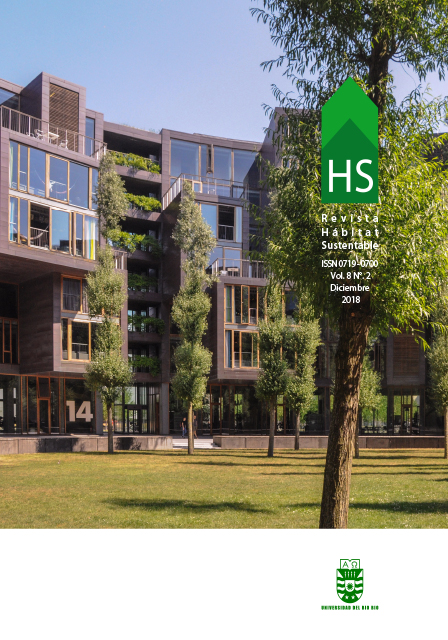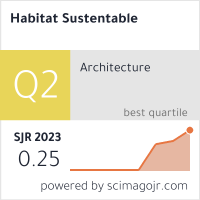Rentabilidad de las estrategias pasivas de eficiencia energetica para la industria del vino. Análisis termo-energético y económico
DOI:
https://doi.org/10.22320/07190700.2018.08.02.07Palabras clave:
eficiencia energética, análisis del costo de vida, decisiones de inversión, eco-eficiencia, vinificaciónResumen
En el siguiente artículo se aborda un estudio cuali-cuantitativo y experimental sobre el caso de una bodega elaboradora de vinos finos, localizada en Argentina. Con ese fin, se lleva a cabo un relevamiento arquitectónico y un seguimiento térmico con sensores en las instalaciones de vinificación durante el período de molienda. Caracterizada la industria y extraídos los datos de temperatura de los procesos y el clima, se construye un modelo de simulación en régimen estacionario. Mediante este modelo -validado con los datos reales-, se simulan estrategias pasivas aplicadas sobre la envolvente de la bodega y del tanque de fermentación. Se estiman, luego, los ahorros en la demanda energética en control térmico del proceso de vinificación obtenidos a través de las estrategias pasivas simuladas. Se definen cuantitativamente las estrategias pasivas más efectivas en la reducción de la demanda energética, se elabora un presupuesto para la construcción de esas estrategias y se confecciona un flujo de fondos de diez años para cada una de ellas. A partir de este análisis integrador, se obtienen los indicadores de rentabilidad de la inversión en cada estrategia: la Tasa Interna de Retorno (TIR) y el Valor Actual Neto (VAN). Posteriormente, se complementan los datos con el período de tiempo requerido para recuperar la inversión -Período de Retorno-, medido en años. Se analizan, finalmente, los factores económico-energéticos que inciden sobre la rentabilidad de las inversiones en eficiencia energética para el caso de la industria, distinguiendo las implicancias en el empleo entre las metodologías del Período de Retorno y el flujo de fondos.
Descargas
Citas
BANCO MUNDIAL. Bases de Datos, Indicadores [en línea]. 2018. [Consultado 06 julio 2018] Disponible en: https://datos. bancomundial.org/indicador/
CEPALSTAT. Bases de Datos y Publicaciones Estadísticas de la Comisión Económica para América Latina (CEPAL). 2018. [Consultado 12 julio 2018]. Disponible en: http://estadisticas. cepal.org/cepalstat/
DATOSMACRO. Bonos a diez años [en línea]. 2018. [Consultado 12 julio 2018]. Disponible en: https://datosmacro.expansion. com/
DEPARTMENT OF INDUSTRY, TOURISM AND RESOURCES [en línea]. 2012. [Consultado 12 julio 2018]. Disponible en: http:// industry.gov.au
FORSYTH, Karl. Improving Wine Refrigeration Efficiency [en línea]. Australian Wine Research Institute, 2012. [Consultado 12 julio 2018]. Disponible en: https://www.awri.com.au
GALITSKY, Christina; WORRELL, Ernst; RADSPIELER, Anthony; HEALY, Patrick y ZECHIEL, Sussane. BEST Winery Guidebook. Benchmarking and Energy and Water Savings Tool for the wine industry [en línea]. 2005. [Consultado 12 julio 2018]. Disponible en:https://www.lbl.gov/
GITMAN, Lawrence y ZUTTER, Chad. Principios de Administración Financiera. 12° Ed, Pearson Education, 2012.
HANSEN, Don R. y MOWEN, Maryanne. Administración de Costos. Contabilidad y Control. 5 Ed. Thomson, 2006.
INSTITUTE OF TECHNOLOGY; RISKLAYER GMBH; AUSTRALIAN NATIONAL UNIVERSITY; GRIFFITH UNIVERSITY; UNIVERSITY OF ADELAIDE Y UNIVERSITY OF NEW SOUTH WALES. Winerisk [en línea]. 2018. [Consultado 12 julio 2018]. Disponible en: http://www.winerisk.com/
INSTITUTO ARGENTINO DE NORMALIZACIÓN. IRAM11603. Clasificación Bioambiental de la República Argentina. Buenos Aires, Argentina, 1996.
INSTITUTO NACIONAL DE TECNOLOGÍA INDUSTRIAL (INTA). Avances y estado de situación en análisis de ciclo de vida y huellas Av15 ambientales en Argentina. En: Actas del IV Encuentro Argentina de Ciclo de Vida y III Encuentro de la Red Argentina de Huella Hídrica ENARCIV 2015 [en línea]. [Consultado 12 julio 2018]. Disponible en: http://www.inta. gob.ar/
INSTITUTO NACIONAL DE VITIVINICULTURA (INV). Estadísticas varias [en línea]. 2018. [Consultado 12 julio 2018]. Disponible en: http://www.inv.gov.ar/
LABS, K. Regional Analysis of ground and underground climate conclusion, Underground Space, 1982, vol. 7, pp. 37-65.
MARTÍN OCAÑA, Silvia y CAÑAS, Ignacio. Study of the termalbehavoir of traditional wine cellars: the case study of the area of Tierras Sorianas del Cid (Spain), ELSEVIER, Renewable Energy, 2005, n° 30, pp. 43-55
MINISTERIO DE CIENCIA, TECNOLOGÍA E INNOVACIÓN PRODUCTIVA Y MINISTERIO DE AGROINDUSTRIA DE LA NACIÓN ARGENTINA. Curso Virtual de Introducción a la Bioeconomía (2017/2018) [en línea]. [Consultado 12 julio 2018]. Disponible en la plataforma web del Curso on line.
MINISTERIO DE ENERGÍA Y MINERÍA DE LA NACIÓN ARGENTINA. Estadísticas Energéticas [en línea]. 2015. [Consultado 12 julio 2018]. Disponible en: https://www. argentina.gob.ar/energia/energia-electrica.
NATIONAL INSTITUTE OF STANDARDS AND TECHNOLOGY (NIST). Energy Price Indices and Discount Factors for Life- Cycle Cost Analysis – 2017 [en línea]. 2017. DOI: https://doi. org/10.6028/NIST.IR.85-3273-32
ORGANIZACIÓN INTERNACIONAL DE LA VIÑA Y EL VINO (OIV). Bases de Datos [en línea]. 2018. [Consultado 12 julio 2018]. Disponible en: http://www.oiv.int/
RAMOS SANZ, Alba. El Confort del Vino en la Envolvente Industrial. Estudio de casos de vasijas vinarias de Bodegas argentinas. Saarbrücken, Alemania: Editorial Publicia, 2014.
RAMOS SANZ, Alba. Reducción de la demanda térmica originada en la vinificación en bodegas localizadas en zona de clima árido, mediante modelado térmico semi-empírico, Hábitat Sustentable, 2015, vol. 5, n° 2, pp. 6-19.
RAMOS SANZ, Alba. Eficiencia Energética de tecnologías productivas frente al calentamiento global, Revista Informes de la Construcción, 2018 (en prensa).
RAMOS SANZ, Alba; JUANICÓ, Luis y KUCHEN, Ernesto. Beneficios Termo energéticos y económicos obtenidos en la simulación de estrategias pasivas aplicadas a la vinificación. Ponencia presentada en Congreso ASADES 2016, Asociación Argentina de Energías Renovables y Medio Ambiente. La Plata, Buenos Aires, República Argentina.
SOUTH AUSTRALIAN WINE INDUSTRY. The Winery Energy Saver Toolkit [en línea]. 2018. [Consultado 12 julio 2018]. Disponible en http://www.winesa.asn.au/members/advice- information/environment/energy-efficiency/winery-energy- saver-toolkit/
TINTI, Francesco; BARABARESI, Alberto; BENNI, Stefano; TORREGGIANI, Daniele; BRUNO, Roberto y TASSINARI, Patrizia. Experimental analysis of shallow underground temperature for the assessment of energy efficiency potential of underground wine cellars, Energy and Buildings, 2014, vol. 80, pp. 451-460.
TINTI, Franceso; BARABARESI, Alberto; FERRARI, Marco; ELKARMOTY, Mohamed; TORREGGIANI, Daniele; TASSINARI, Patrizia; BONDUÀ, Stefano. Experimental calibration of underground heat transfer models under a winery building in a rural area, The Mining-Geology-Petroleum Engineering Bulletin [en línea], 2017. [Consultado 12 julio 2018]. Disponible en: https://hrcak.srce.hr/ojs/index.php/rgn/article/view/4936/pdf
US DEPARTAMENT OF STATE GEOGRAPHER. Google Earth Pro [en línea]. 2018. [Consultado 12 julio 2018]. Disponible en: https://www.google.com.ar/intl/es/earth/
Descargas
Publicado
Cómo citar
Número
Sección
Licencia
El contenido de los artículos que se publican en cada número de Hábitat Sustentable, es responsabilidad exclusiva de los autores y no representan necesariamente el pensamiento ni comprometen la opinión de la Universidad del Bío-Bío.
Los autores/as conservarán sus derechos de autor y garantizarán a la revista el derecho de primera publicación de su obra, el cuál estará simultáneamente sujeto a la Licencia de Reconocimiento de Creative Commons CC BY-SA que permite a otros compartir-copiar, transformar o crear nuevo material a partir de esta obra con fines no comerciales, siempre y cuando se reconozcan la autoría y la primera publicación en esta revista, y sus nuevas creaciones estén bajo una licencia con los mismos términos.











 Programa de Información Científica/Concurso Fondos de Publicación de Revistas Científicas 2018/ Proyecto Mejoramiento de Visibilidad de Revistas UBB (Código:FP180007)
Programa de Información Científica/Concurso Fondos de Publicación de Revistas Científicas 2018/ Proyecto Mejoramiento de Visibilidad de Revistas UBB (Código:FP180007) 





